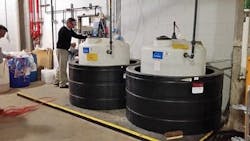Commercial Water: Chemical Treatment for Cooling Towers
Like cooling tower owners across the U.S., the facilities managers/system owners at a major Midwestern university face pressure to optimize the performance of their cooling tower/chiller systems with a limited budget. This situation is further complicated by the new ANSI/ASHRAE Standard 188-2015, Legionellosis: Risk Management for Building Water Systems, which requires extensive review and planning, and potential changes in water treatment programs. University-wide teams are being formed to comprehensively address water issues while experts responsible for affected facilities are reviewing options and collecting vital information.
The preliminary results from the trial of a new treatment program at the university confirmed an option that owners and water treatment professionals can employ to meet anticipated requirements. The chemical treatment program proved effective on multiple sources of fouling, offered reductions in maintenance resources and improved worker safety.
Corrosion rates were controlled and total bacteria counts were below allowable levels. The low toxicity of the chemical also offered a green profile. The initial trial will continue, and planning is under way for installations in other campus facilities.
Background & Trial Design
In early 2015, an eight-month trial of the Mexel 432/0 chemical treatment program was commissioned to determine its efficacy on existing challenges in the water circuits. Due to developing attention to ANSI/ASHRAE 188-2015, the results also would be evaluated for inclusion in future treatment program design. Typical problems included scaling of towers and chillers associated with the variable and elevated hardness of the municipal makeup water, and difficulty maintaining acceptable corrosion levels for copper and mild steel. Calculated hardness ranged from 92 to 180 and corrosion rates were above acceptable standards using a bromine and phosphate polymer treatment program.
A 40,000-gal cooling tower/chiller system composed of two 1,200-ton centrifugal chillers, a 650-ton chiller and two cooling towers was selected for the trial. The treatment consisted of injecting a single emulsion of filming amines to achieve a residual level of 2 to 2.5 ppm for 30 minutes per day. The emulsion replaced all other chemicals previously used for treatment.
The treatment coats interior wetted surfaces with a protective layer at the molecular level to prevent fouling. The coating controls biofouling, scaling and corrosion. It has a mild detergent/dispersant action, providing remediation of existing deposits. A single metering pump was attached to the existing controller, and corrosion coupon racks were installed to allow bimonthly testing and frequent Corrater readings. Dip slides were used to track total bacteria.
Preliminary Results
At the start of the trial, the towers were found to contain mud and biological fouling. Scale also had accumulated on the tower fill, but resource limitations did not allow for cleaning prior to cooling season. During the season, conductivity control over the towers was lost several times due to equipment failures. After repairs, system balances were restored and parameters returned to expected levels.
During the trial, university staff monitored performance weekly. The dosing equipment provided chemical at the required rate, with minor adjustments to maintain preferred residual levels. Corrater readings were consistently below 3 mils per year (mpy) for mild copper and 0.3 mpy during normal operations. Total aerobic bacteria counts remained within control and decreased to low levels as the season progressed. Scaling on the tower fill was reduced, and planned condenser inspections were expected to show similar results.
When reviewing preliminary data, university staff noted that the treatment would improve operations and maintenance resource requirements. Because the dosing did not require frequent adjustments with changes in water chemistry, monitoring requirements were reduced. The concentrated formula reduced transportation, storage and handling requirements. Reduced chiller cleaning also was anticipated, along with increased efficiency of heat transfer in the tower and chiller throughout the season.
Another key concern was worker and public safety. Recent U.S. Environmental Protection Agency registration testing showed the product to be non-toxic to humans, with low toxicity to aquatic organisms when discharged. The product also does not burn, explode or volatilize.
The university is moving forward in implementing and assessing this technology in a broader range of applications. If future results confirm the initial findings, expanded adoption on campus is expected.
Download: Here
